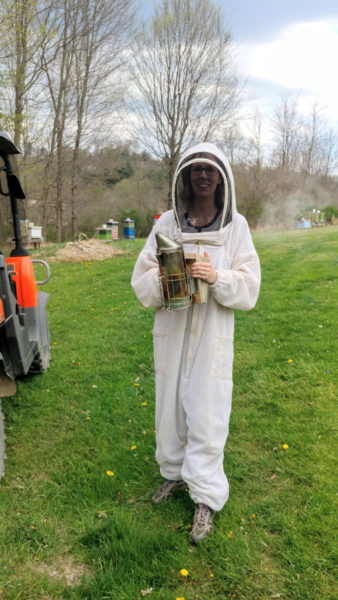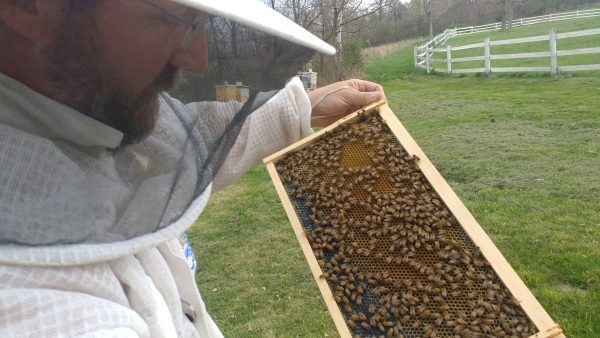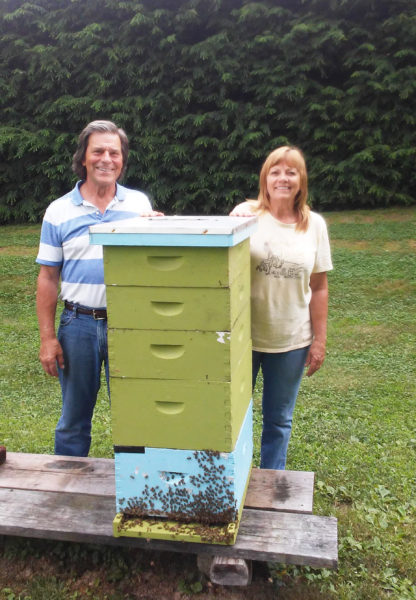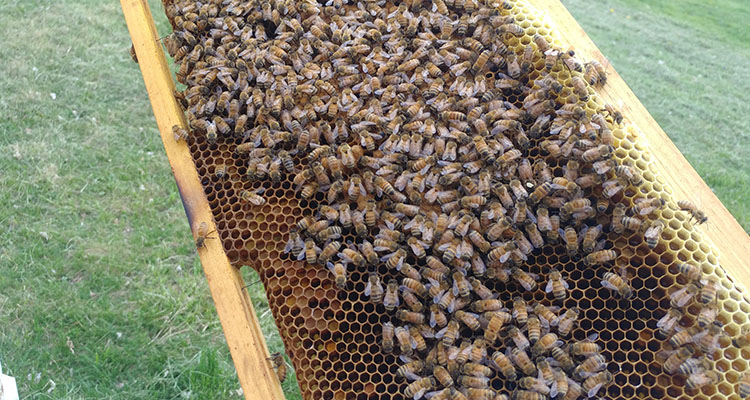I’m stepping into a beekeeper’s suit today. It’s not heavy garb, but it’s puffy and cumbersome. Once the hood goes over my head and the gloves go on, there’s no way to scratch my nose, which immediately begins to itch. I look at my phone in my hand and wonder how I’m going to take pictures.
John Welty, a local master beekeeper and owner of Windswept Farm, hands me a pen with a rubber tip for my phone/camera. He’s invited me to his apiary to meet his honeybees, or “the girls,” as he calls them. They live in a few dozen hives on his property, and they’re his personal passion. I’ve never met bees before, but I’m looking forward to it.
His hives are pastel-colored boxes sitting on the edge of the woods, about 18 inches off the ground. They’re raised to that height to deter skunks, the only local varmint who troubles itself with a beehive. Bears can be a real problem, but not in our area.
Once I’m zipped in and sealed up, I can get a comfortable look at the insect activity around the hive. I make sure to stand to the side so I don’t block the entrance.
“It’s so meditative to watch these guys come in and out,” Welty says. “A good beekeeper can look at the front of his hive and tell a lot before he even goes in.”

I see bees leaving, bees returning, and several who arrive with pollen on their back legs. This indicates to Welty that the queen is alive and laying eggs. That expanding brood eats a lot. It’s a big job to feed 50,000 mouths, but the worker bees are up to the challenge.
“Bees eat pollen. It’s their protein,” he tells me. “They also eat nectar or honey, and it’s their carbohydrate.”
Welty carries a smoker that calms the bees. He gives them a light puff to let them know he’s there and uses a hive tool to gently lift the lid, moving slowly and methodically. When the lid comes off, I see 10 frames sitting side by side. One by one, he begins to remove the frames so I can get a look at the inner workings of the colony. While the outer frames have limited activity with a few dozen bees on each and no shortage of wax, the busyness increases as he moves inward. We can expect a frenzy of activity when we find the frame with the queen. I’m excited to get a look at her.
The worker bees are in constant motion, crawling all over each frame and each other. Many work on honey production. After they collect the nectar, they add enzymes, put it in a cell and fan their wings over it until the water content reaches 18 percent. At this point it becomes honey, and they cap it off and eat it for sustenance. I also see them tending to larva, which look like a tiny white grain of rice. Over 21 days, the larvae grow and finally emerge as adult worker bees.
Welty pulls out frame after frame as we look for the queen. Close to the middle, I see a handful of bigger, beefier bees. They look like football players compared to the worker bees, and they’re not doing a whole lot. These are the drones, the only male bees in the colony. In a hive of 50,000 bees, perhaps a thousand are drones. They have one job: to find a queen and mate with her. The act ends their lives. Until that time, they sit around and let the worker bees feed them.
We continue to search the frames for the queen.
“The [worker bees] follow her like a dog,” Welty explains, as we pore over hundreds of busy insects. “She has the queen pheromone. They know that she’s the queen. They feed her. She doesn’t eat by herself. They clean her, they clean for her. They do everything for her.” I strain my eyes as I look through the mesh of my protective headgear. Where is she? How do you find one bee in fifty thousand?

• • •
Like John Welty, Steve Roth is a master beekeeper. He’s also West Virginia’s 2018 Beekeeper of the Year and president of Tri-State Beekeeper’s Association here in the valley, and he invited me to his own farm on a chilly April day. Steve and his wife, Kathie, crossed paths with my family when we had a bee issue. For many years, a wild colony of honeybees resided about 12 feet up in an old tree. The entrance to the hive was so high that passersby weren’t affected by or even aware of the bees’ presence. Then, one day, they swarmed.
Perhaps you’ve seen a swarm of honeybees. They might collect on a traffic cone or a car hood or a tree trunk. This isn’t an act of aggression but a product of overcrowding. When the hive gets too crowded, the queen departs with about half the colony. While they rest on that traffic cone, scouts are on the move, looking for a new home. When our bees swarmed, Kathie arrived with a bee vacuum. Quickly and gently, she sucked up the queen and the colony where they rested and put them in a hive. Those bees now travel around town doing what honeybees do best: pollinate.

Pollination is big business. You can, essentially, rent honeybees for your pollination needs. Professional beekeepers run a yearly circuit with their hives. Eighty percent of all the hives in the United States travel to California in February to pollinate the almond trees. 1.3 million hives are trucked into California each year. They visit Oregon for apples, New Mexico for peppers, the south for fruits, Delaware for cucumbers, and finish the pollinating season in Maine for cranberries and blueberries.
If you’re a local beekeeper who wants to remain local, you’re in luck: Roth told me that West Virginia is an ideal location for honeybees.
“Wheeling is perfect for beekeeping because we have such an abundance of trees,” he said. “We have some suburban landscaping, but the trees are the real source of [bee] nutrition. You may have 100 blooms in one section [of your garden], but the trees have 10,000 blossoms. Where do you think the bees are going to be?” He also points out that, while honey may be labeled “clover” or “buckwheat,” there’s no way to know for certain that the bees are exclusive to those plants. Therefore, the honey that Roth’s and Welty’s bees produce is, simply, “wildflower” honey. They leave the hive and find what they can. And that’s better for the bees.
“Bees that are raised purely over one crop are not that healthy,” Roth said. “We have a perfect variety right out our back door. West Virginia really is an abundance of nutrition.”
A honeybee can fly about a mile and a quarter to forage. When she finds a fruitful site, whether it’s a wealth of pollen or nectar, she returns to the hive to share the news. Other workers unload her bounty, and then she tells them about her find.
“If it’s a really beneficial site,” Roth said, “she’ll do a dance to tell those other bees where it is. It’s called the waggle dance. It’s a figure eight dance. She’s orienting off the sun. So, if she wants them to go out and go 30 degrees to the right, her dance will incline 30 degrees to the right. The intensity of her dance tells them the distance. A mile away, she can put them within 10 meters of that site. Honeybees have a tremendous sense of smell. They touch her while she does the dance so she can help direct them.” She even accounts for the movement of the sun across the horizon while she’s dancing. Her dance will change one degree every four minutes.
“The more I know, the less I know,” Roth admitted. “I’m in awe of their abilities.”
• • •
Still zipped into a beekeeper’s suit at John Welty’s Windswept Farm, I remember everything I learned from Roth. I’m in awe, too, and I’m getting anxious to see the queen. We’ve examined six out of 10 frames, and I can tell we’re getting close because there are more and more bees on each one. Welty holds up frame No. 7 and points out a worker bee. She’s vibrating and turning around and around. The other bees are touching her as she repeats her movements over and over. It’s the waggle dance! It’s one thing to hear about it; it’s another to see this tiny insect giving precise directions to a bountiful harvest somewhere out in the woods based on the angle of the sun. How do they know how do to this? Nature astounds me, and for a moment I’m stunned into silence.
John flips the frame over. It’s a mass of honeybees. They’re piled on top of each other. Each one has a job to do, whether it’s food-related or brood-related. Even though it looks like chaos, they work efficiently.
And then, we see her. The queen.
She’s marked with a white spot so we can find her more easily. She looks like the worker bees, but her abdomen is quite a bit longer. In it, she stores all the eggs she’ll lay in her life. The worker bees do indeed follow her like dogs. And yet, despite the importance of the queen, it’s the worker bees who are really in charge. The queen is vital to the colony’s survival, and she’s treated accordingly. But it’s a democracy in here, not a monarchy. The worker bees can raise a new queen. Or kill this one. There’s a balance of power in a honeybee hive.
Suddenly, I’m stung. Or, more accurately, my bee suit is stung. The little worker bee is just trying to defend her home, and I watch as she stings the arm of my suit and then dies. Stings are fatal to workers. I feel terrible.
“When you first get bees,” Welty tells me, “you’re so cautious. You don’t sleep for a week when you accidentally squish one.” Then, he says, you start to chill out. Bee stings are a fact of beekeeping. You’re going to get stung once in a while, but unless you’re allergic, it’s just part of the deal.
“Are you sad that happened?” he asks me. I tell him I feel like a dirty dog. There’s now one less honeybee in the world, and they’re already in grave danger of extinction.
Aren’t they?
Read part 2 of Laura’s story here.
• Laura Jackson Roberts is a freelance writer in Wheeling, W.Va. She holds an MFA in Creative Writing from Chatham University and writes about nature and the environment. Her work has recently appeared in Brain, Child Magazine, Vandaleer, Animal, Matador Network, Defenestration, The Higgs Weldon and the Erma Bombeck humor site. Laura is the Northern Panhandle representative for West Virginia Writers, a blog editor for Literary Mama Magazine and a member of Ohio Valley Writers. She recently finished her first book of humor. Laura lives in Wheeling with her husband and their sons. Visit her online at www.laurajacksonroberts.com.




